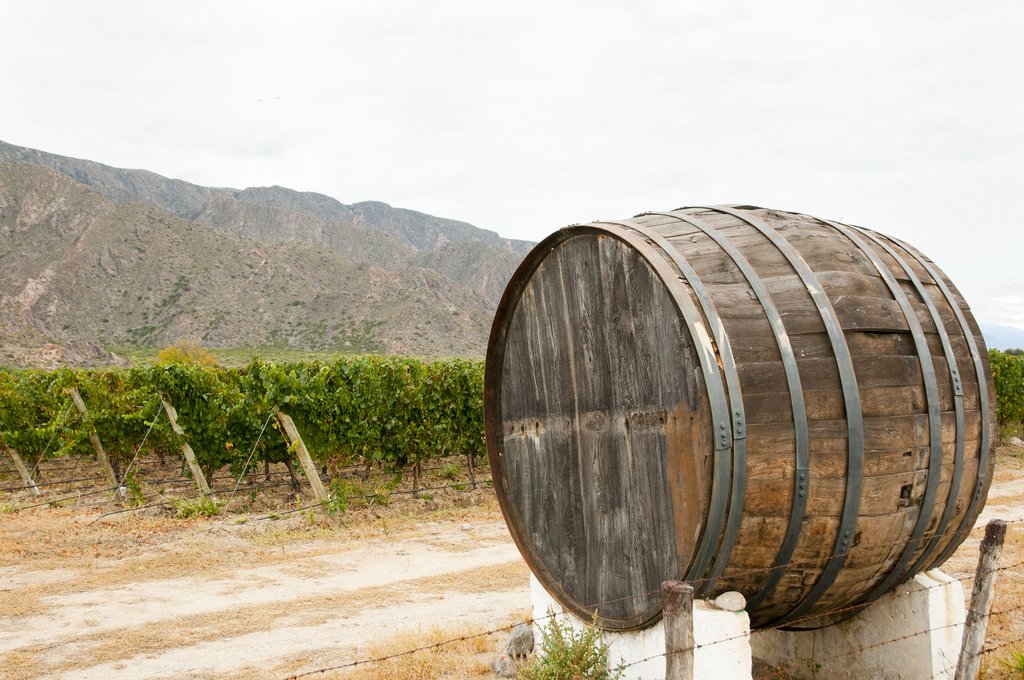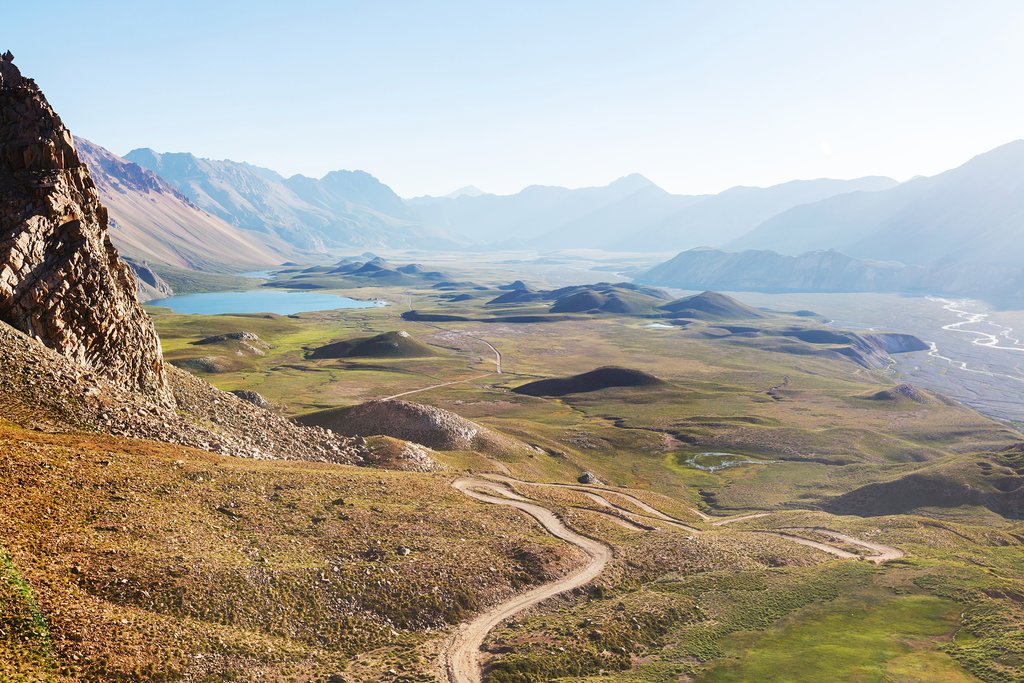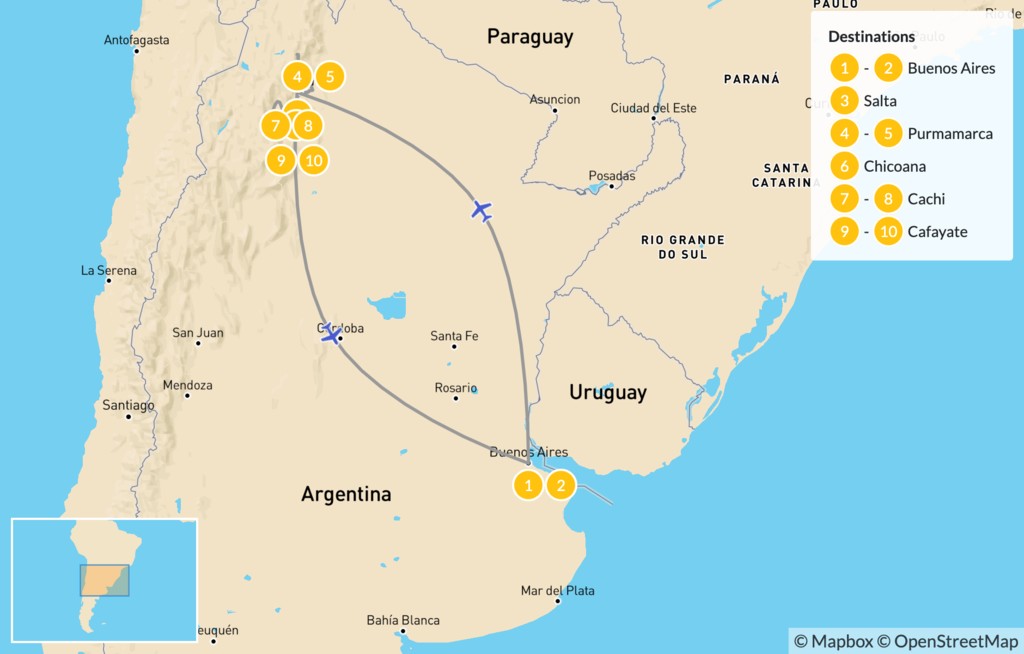Highlights
- Enjoy dinner and a tango show in Buenos Aires
- Take a city tour of Salta, the most beautiful city in northern Argentina
- Visit the expansive salt flats and painted mountains outside Salta
- Tour historic colonial towns like Cachi and Cafayate
- Embark on a wine tour in the Calchaquí Valley
Brief Itinerary
| Day | Highlights | Overnight |
|---|---|---|
| Day 1 | Arrival in Buenos Aires | Buenos Aires |
| Day 2 | Walking Tour of Buenos Aires | Buenos Aires |
| Day 3 | Fly from Buenos Aires to Salta | Salta |
| Day 4 | Salta to Purmamarca - Day Trip to Quebrada de Humahuaca | Purmamarca |
| Day 5 | Pumamarca to Salinas Grandes | Purmamarca |
| Day 6 | Purmamarca to Chicoana - Country Horseback Ride | Chicoana |
| Day 7 | Chicoana to Cachi | Cachi |
| Day 8 | Free Day in Cachi | Cachi |
| Day 9 | Cachi to Cafayate - Wine Tour | Cafayate |
| Day 10 | Visit Ruinas de Quilmes | Cafayate |
| Day 11 | Depart Argentina |
Detailed Itinerary
Day 1: Arrival in Buenos Aires

Welcome to Argentina! Renowned as the "Paris of South America" and the "Queen of El Plata," the capital city of Buenos Aires is defined by passion. This is exemplified in the rich tango heritage and its citizens' limitless enthusiasm for fútbol (soccer), which is by far the country's most popular sport.
When you arrive at the airport, your driver will be waiting to take you in a private car to your hotel where you can relax after a long flight. But make no mistake: the city will beckon you. So after a quick recharge, be sure to venture out into the welcoming arms of Buenos Aires and explore.
When evening falls and dinnertime arrives, do like the locals and order a thick, juicy steak (Argentina has some of the best beef in the world) drizzled with the nation's famous chimichurri (a garlic, herb, and vinegar sauce). Know that Buenos Aires is a culture that thrives after dark, and it's not uncommon for locals to have dinner well past nine in the evening, especially on weekends.
Day 2: Walking Tour of Buenos Aires

After breakfast, you'll take an organized tour of Buenos Aires. During this three-hour walking excursion, you'll visit the neighborhood of Retiro plus stroll Avenida 9 de Julio—South America’s widest avenue. You'll pass through the historic city center, home to the Teatro Colón opera house, National Congress, Plaza de Mayo, and the Casa Rosada (Presidential Palace). Then, visit the oldest neighborhood in the city, San Telmo. Afterward, you'll stop by the city's original port, La Boca.
In the evening, enjoy a delicious meal accompanied by a tango performance—one of Argentina's most well-known cultural highlights.
Day 3: Fly from Buenos Aires to Salta

This morning, transfer to the airport to board your flight to Salta, one of Argentina's most impressive Spanish colonial cities. Upon arrival, you'll be greeted at the airport and transferred to your hotel. Take the rest of the day to get settled in and enjoy the town. Easy to explore on foot, Salta's colonial center is lined with gorgeous neoclassical buildings, lively cafes, and cool bars that draw a young and energetic crowd.
Recommended activities include:
- Take the cable car up Cerro San Bernardo to enjoy the spectacular panoramic views of the city and beyond.
- Appreciate the city's beautiful architecture by visiting the pink Salta Cathedral, consecrated in 1878, as well as the Church of San Francisco, and Baroque City Hall building.
- Visit the Museum of High Altitude Archaeology, which sheds light on important archaeological discoveries in the Andes.
- Learn about the region's rich history by paying a visit to the Historical Museum of the North, which showcases items from local indigenous cultures as well as colonial times.
- Stroll around the craft market, where you can buy artisanal products including rugs and pottery.
Day 4: Salta to Purmamarca - Day Trip to Quebrada de Humahuaca

There are few more mystic, historic, and evocative areas in Argentina than the Quebrada de Humahuaca. This arid desert valley gets its start in the high altitude Andean plateaus before running down into Jujuy Province and meeting the Río Grande, at which point it forms a 96-mile (155-km) corridor.
This valley gorge has been populated for over 10,000 years, starting with the earliest hunter-gatherers. It then became an important Incan trading route in the 15th and 16th centuries and later was a link between the Viceroyalty of Buenos Aires and the Viceroyalty of Peru. It was even an important battleground in the War of Independence. You can see remnants of Pre-Columbian towns here, and white-washed colonial chapels still dot the valley.
Your tour of the area begins with a pick up at your hotel in Salta at 7 am. The first place you'll visit is the village of Purmamarca, where you'll find the famous Cerro de Siete Colores (Hill of the Seven Colors), which is notable for its strata, which is seemingly "painted" various shades of red. Other notable sites in the village include the whitewashed Iglesia de Santa Rosa, and the artisanal craft market.
You'll head a few kilometers north to the town of Tilcara and Pucará de Tilcara, the hilltop remains of a pre-historic fortress. Here you'll visit a fascinating archeological museum. Next is Huacalera, located two kilometers north of the Tropic of Capricorn (a giant sundial marks the exact location).
Then you'll visit the tiny village of Uquía, which boasts one of the most impressive whitewashed churches in the region, the Iglesia San Francisco de Paula, which was built in 1691. Inside you'll find a number of paintings done in the Cuzco style and featuring angels in 17th-century battle dress. Before lunch, you'll Arrive at the town of Humahuaca, which is denoted by its labyrinthine narrow streets, adobe houses, and its monument to independence, El Indio, done by sculptor Soto Avendaño.
After lunch, you'll head to Maimará, a town notable for its haunting hillside cemetery and the brightly colored mountains that surround it. These are known as La Paleta del Pintor (The Painter's Palette). If time allows, we will return to Salta via the Abra de Santa Laura ( a mountain path lined with subtropical vegetation), which is surrounded by stunning scenery, including Las Maderas Dam, and the Campo Alegre reservoir.
In the evening, transfer to your hotel in Purmamarca where you'll spend the evening.
Chat with a local specialist who can help organize your trip.
Day 5: Pumamarca to Salinas Grandes

After breakfast, you'll drive along the Cuesta de Lipan, a spectacular tract of winding mountain road, to Salinas Grandes. This expansive salt flat lies high up in the puna and covers an area of 81 square miles (212 sq. km). Once a lake, the flat is comprised of a salt crust that’s half a meter thick.
On a tour of the area, you’ll walk along the flat and learn how salt is extracted from this vast expanse. Take some time to snap photos and enjoy the panoramic views, which look out to the snow-capped Nevado de Chañi. In the afternoon you'll transfer back to Pumamarca, where you'll overnight.
Day 6: Purmamarca to Chicoana - Country Horseback Ride

In the morning, you'll drive from Purmamarca south towards Salta, continuing past the city another 45 minutes to the rural area of Chicoana. Your destination is a traditional finca (ranch) located in the countryside. Here you'll learn about traditional gaucho (cowboy) culture and explore the nearby dusty roads and trails on horseback.
As an added bonus, you'll have the option to overnight at the finca or embark on a horseback ride and camping excursion in the surrounding mountains. Whichever you choose, you’ll enjoy a traditional asado (BBQ) feast at least once during your stay.
Day 7: Chicoana to Cachi

From Chicoana, you'll drive two hours west to Cachi. This may be a small town, but it's one of the most beautiful in Argentina. Located in the Calchaquí Valley, Cachi is denoted by its whitewashed adobe houses, wide plazas, Spanish-colonial chapel, and cobbled streets.
After checking in to your hotel, you'll have the rest of the day free. You can spend this time exploring the streets, interacting with locals, and browsing the shops for traditional handicrafts. Don't miss the Cachi Archeological Museum, which features thousands of artifacts spanning the pre-ceramic era to the Inca Empire to the Hispanic-Indian and colonial periods.
Also, if you happen to be traveling between April and May, you'll have the option to take a pepper tour where you'll visit rows of bright red peppers being harvested for paprika.
Day 8: Free Day in Cachi

Today is a free day to spend however you wish. We recommend venturing beyond town and exploring the region around Cachi. One option is to travel to the nearby village of San Carlos and visit a local artisan to see how they craft handmade pottery. Or you can embark on a guided hike through the Acsibi Caves, a network of desert caves that are positively Martian in their red-hued geologic formations.
Then there's the Quebrada de las Flechas. This expansive canyon stretches for 12 miles (20 km) and is characterized by endless craggy rock formations protruding out of the ground. All in all, its a scene of dramatic beauty that's truly unique to the area.
Day 9: Cachi to Cafayate - Wine Tour

The multicolored mountains and canyons around the town of Cafayate lie 3.5 hours south of Cachi. You'll arrive here via the famous Route 40, and the stunning desert scenery is sure to keep you entertained during the drive. Of course, there will be many pit-stops along the way to stretch your legs and snap photos.
After arriving in the city, take a stroll and do some souvenir shopping around the main square, or head straight to a vineyard and bodega for empanadas and a wine tasting. The dry climate that creates such spectacular scenery here is also ideal for growing some of the best and most unique wine in the country. Torrontes is one such varietal. This dry white wine is cultivated mostly in the Calchaquí Valley.
Day 10: Visit Ruinas de Quilmes

After enjoying breakfast at your hotel, you'll head to Ruinas de Quilmes, the largest Pre-Columbian settlement in Argentina. The entire archeological site covers about 75 acres and dates back to the middle of the 9th century. Back then it was home to over 5,000 members of the Quilmes indigenous people.
On a tour of the site, you'll get to walk around the remains of the terraced settlement, which rises up a hillside. You can visit the ruins of stone dwellings as well as see the stone tools that the residents used in their daily life. There's a museum here as well as a restaurant should you desire refreshments.
In the afternoon you’ll return to Cafayate where you'll have the rest of the day to relax and explore at your leisure.
Day 11: Depart Argentina

After breakfast, you'll catch a flight from Salta to Buenos Aires (about 2 hours), then head to the international terminal for your return flight home. Buen viaje!


